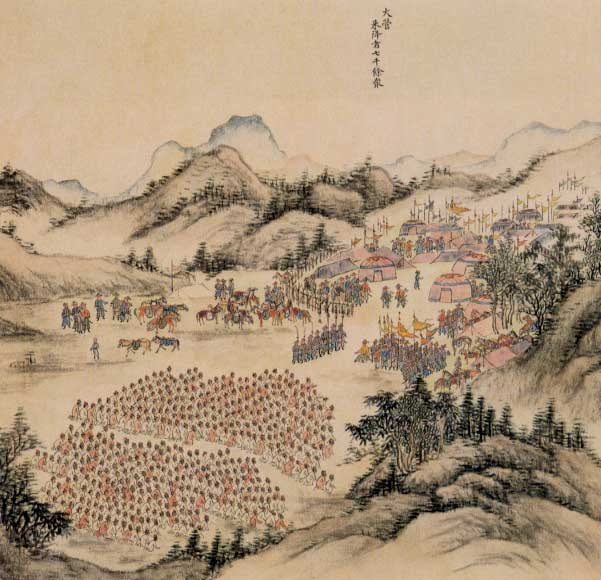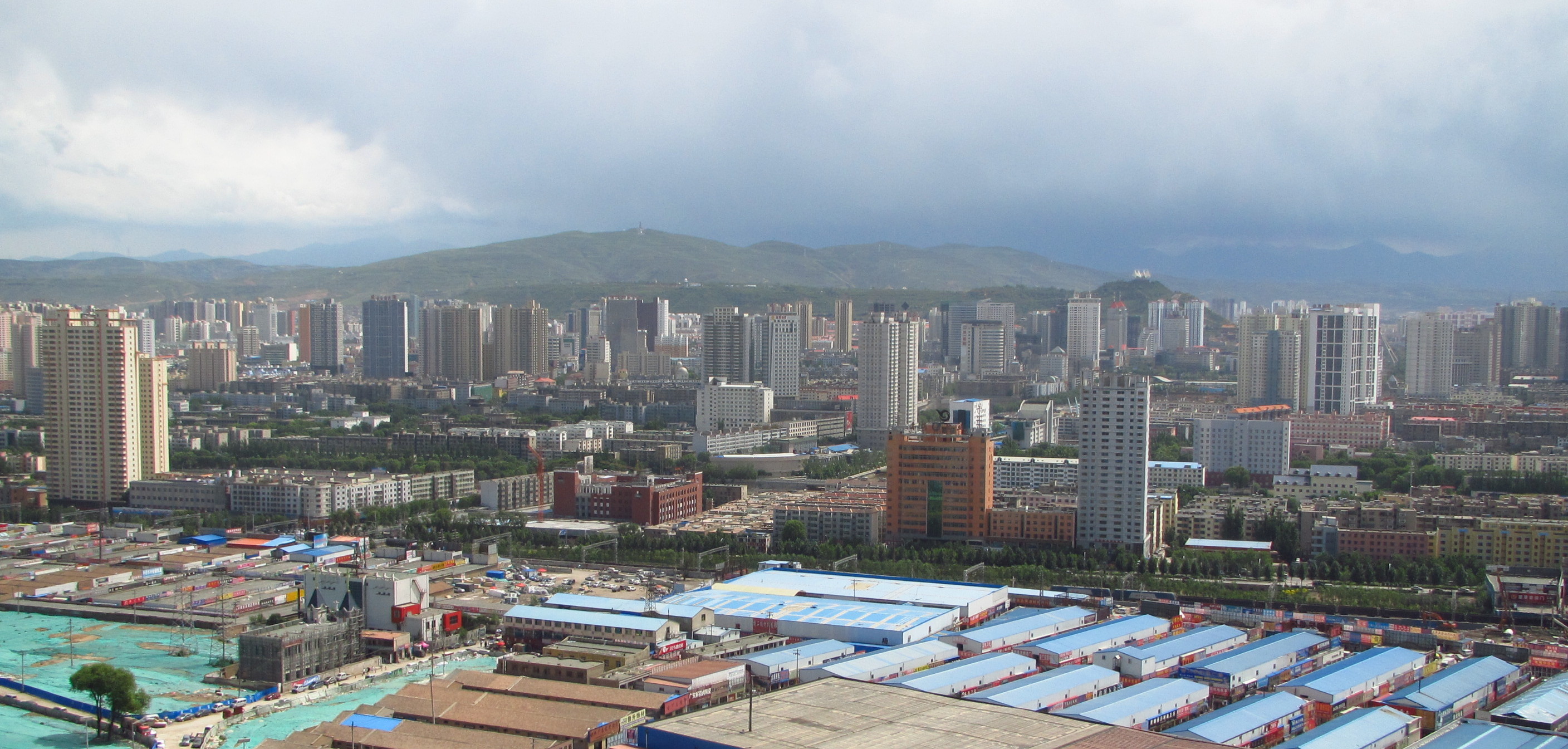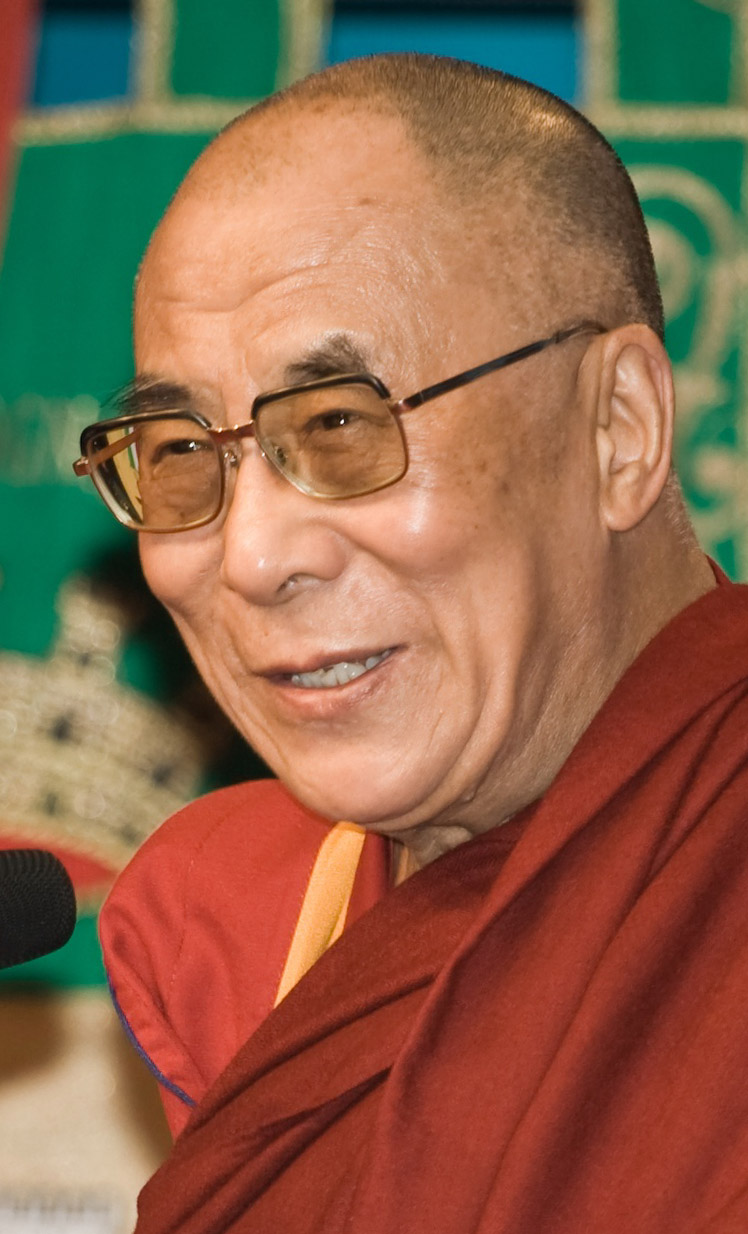|
Battle Of The Salween River
The Battle of the Salween River () was fought in September 1718 close to the Nagqu (i.e., Salween River) in Tibet, between an expedition of the Qing dynasty to Lhasa and a Dzungar Khanate force that blocked its path. After Tsering Dhondup conquered Tibet in 1717 on the orders of his cousin, the Dzungar Khong Tayiji Tsewang Rabtan, the Qing Kangxi Emperor ordered his generals to muster an army and expel the Dzungars and their supporters from Tibet but the enormous distances and logistical difficulties prevented an immediate reaction. By 1718 the Qing were mustering an expedition in Xining made up of Chinese and Muslim soldiers.Desideri 2010, p. 255 The Chinese took the shortest route to Lhasa which took them west of Xining and through a deserted area to Lhasa.Desideri 2010, p. 255 The long journey through a deserted country exhausted the expedition's supplies and sickened the soldiers so as to make Erentei halt the march in Dam near the Salween River some from Xining,Per ... [...More Info...] [...Related Items...] OR: [Wikipedia] [Google] [Baidu] |
Dzungar–Qing Wars
The Dzungar–Qing Wars (, ) were a decades-long series of conflicts that pitted the Dzungar Khanate against the Qing dynasty and its Mongol vassals. Fighting took place over a wide swath of Inner Asia, from present-day central and eastern Mongolia to Tibet, Qinghai, and Xinjiang regions of present-day China. Qing victories ultimately led to the incorporation of Outer Mongolia, Tibet and Xinjiang into the Qing Empire that was to last until the 1911 Revolution, fall of the dynasty in 1911–1912, and the Dzungar genocide, genocide of much of the Dzungar population in the conquered areas. Background After the collapse of the Yuan dynasty in 1368, China's Mongol rulers withdrew to Mongolia and became known as the Northern Yuan. Over time, the Mongol state disintegrated into a series of Khanates, ruled by various descendants of Genghis Khan. The Qing dynasty defeated the Inner Chahars, Chahar Mongol leader Ligdan Khan and annexed Inner Mongolia. While the Eastern Mongols (Outer a ... [...More Info...] [...Related Items...] OR: [Wikipedia] [Google] [Baidu] |
Xining
Xining is the Capital (political), capital and most populous city of Qinghai province in western China and the largest city on the Tibetan Plateau. As of the 2020 census, it had 2,467,965 inhabitants (2,208,708 as of 2010), of whom 1,954,795 lived in the built-up (or metro) area made of 5 urban districts. The city lies in the Huangshui River, Huangshui River Valley, also known as Tsongkha (Tibetan script, Tibetan: ཙོང་ཁ་), and owing to its high altitude, has a cool climate on the borderline between Semi-arid climate#Cold semi-arid climates, cool semi-arid and dry winter humid continental climate, humid continental. Xining was a commercial hub along the Northern Silk Road's Hexi Corridor for over 2000 years, and was a stronghold of the Han dynasty, Han, Sui dynasty, Sui, Tang dynasty, Tang, and Song dynasty, Song dynasties' resistance against nomadic attacks from the west. Although long a part of Gansu province, Xining was added to Qinghai in 1928. Xining holds sites ... [...More Info...] [...Related Items...] OR: [Wikipedia] [Google] [Baidu] |
1718 In China
Events January – March * January 7 – In India, Sufi rebel leader Shah Inayat Shaheed from Sindh who had led attacks against the Mughal Empire, is beheaded days after being tricked into meeting with the Mughals to discuss peace. * January 17 – Jeremias III reclaims his role as the Ecumenical Patriarch of Constantinople, chief leader within the Eastern Orthodox Church, 16 days after the Metropolitan Cyril IV of Pruoza had engineered an election to become the Patriarch. * February 14 – The reign of Victor Amadeus over the principality of Anhalt-Bernburg (now within the state of Saxony-Anhalt in northeastern Germany) ends after 61 years and 7 months. He had ascended the throne on September 22, 1656. He is succeeded by his son Karl Frederick. * February 21 – Manuel II (Mpanzu a Nimi) becomes the new monarch of the Kingdom of Kongo (located in western Africa in present day Angola) when King Pedro IV (Nusamu a Mvemba) dies after a reign of ... [...More Info...] [...Related Items...] OR: [Wikipedia] [Google] [Baidu] |
Conflicts In 1718
Conflict may refer to: Social sciences * Conflict (process), the general pattern of groups dealing with disparate ideas * Conflict continuum from cooperation (low intensity), to contest, to higher intensity (violence and war) * Conflict of interest, involvement in multiple interests which could possibly corrupt the motivation or decision-making * Cultural conflict, a type of conflict that occurs when different cultural values and beliefs clash * Ethnic conflict, a conflict between two or more contending ethnic groups * Group conflict, conflict between groups * Intragroup conflict, conflict within groups * Organizational conflict, discord caused by opposition of needs, values, and interests between people working together * Role conflict, incompatible demands placed upon a person such that compliance with both would be difficult * Social conflict, the struggle for agency or power in something * Work–family conflict, incompatible demands between the work and family roles of a ... [...More Info...] [...Related Items...] OR: [Wikipedia] [Google] [Baidu] |
Battles Involving Tibet
A battle is an occurrence of combat in warfare between opposing military units of any number or size. A war usually consists of multiple battles. In general, a battle is a military engagement that is well defined in duration, area, and force commitment. An engagement with only limited commitment between the forces and without decisive results is sometimes called a skirmish. The word "battle" can also be used infrequently to refer to an entire operational campaign, although this usage greatly diverges from its conventional or customary meaning. Generally, the word "battle" is used for such campaigns if referring to a protracted combat encounter in which either one or both of the combatants had the same methods, resources, and strategic objectives throughout the encounter. Some prominent examples of this would be the Battle of the Atlantic, Battle of Britain, and the Battle of France, all in World War II. Wars and military campaigns are guided by military strategy, whereas batt ... [...More Info...] [...Related Items...] OR: [Wikipedia] [Google] [Baidu] |
Battles Involving The Qing Dynasty
A battle is an occurrence of combat in warfare between opposing military units of any number or size. A war usually consists of multiple battles. In general, a battle is a military engagement that is well defined in duration, area, and force commitment. An engagement with only limited commitment between the forces and without decisive results is sometimes called a skirmish. The word "battle" can also be used infrequently to refer to an entire operational campaign, although this usage greatly diverges from its conventional or customary meaning. Generally, the word "battle" is used for such campaigns if referring to a protracted combat encounter in which either one or both of the combatants had the same methods, resources, and strategic objectives throughout the encounter. Some prominent examples of this would be the Battle of the Atlantic, Battle of Britain, and the Battle of France, all in World War II. Wars and military campaigns are guided by military strategy, whereas battl ... [...More Info...] [...Related Items...] OR: [Wikipedia] [Google] [Baidu] |
18th-century Military History Of China
The 18th century lasted from 1 January 1701 (represented by the Roman numerals MDCCI) to 31 December 1800 (MDCCC). During the 18th century, elements of Enlightenment thinking culminated in the Atlantic Revolutions. Revolutions began to challenge the legitimacy of monarchical and aristocratic power structures. The Industrial Revolution began mid-century, leading to radical changes in human society and the environment. The European colonization of the Americas and other parts of the world intensified and associated mass migrations of people grew in size as part of the Age of Sail. During the century, slave trading expanded across the shores of the Atlantic Ocean, while declining in Russia and China. Western historians have occasionally defined the 18th century otherwise for the purposes of their work. For example, the "short" 18th century may be defined as 1715–1789, denoting the period of time between the death of Louis XIV of France and the start of the French Revolution, ... [...More Info...] [...Related Items...] OR: [Wikipedia] [Google] [Baidu] |
Tibet Under Qing Rule
Tibet under Qing rule refers to the Qing dynasty's rule over Tibet from 1720 to 1912. The Qing rulers incorporated Tibet into the empire along with Qing dynasty in Inner Asia, other Inner Asia territories, although the actual extent of the Qing dynasty's control over Tibet during this period has been the subject of political debate. The Qing called Tibet a ''fanbu'', ''fanbang'' or ''fanshu'', which has usually been translated as "vassal", "vassal state", or "borderlands", along with areas like Xinjiang and Mongolia. Like the earlier Yuan dynasty, the Manchus of the Qing dynasty exerted military and administrative control over Tibet, while granting it a degree of political autonomy.Starting from extablishment of Imperial Monument to the Pacification of Xizang, term Xizang was officially used to replace older names to designate the region. By 1642, Güshi Khan of the Khoshut Khanate had reunified Tibet under the spiritual and temporal authority of the 5th Dalai Lama of the Gelug sc ... [...More Info...] [...Related Items...] OR: [Wikipedia] [Google] [Baidu] |
Chinese Expedition To Tibet (1720)
The 1720 Chinese expedition to Tibet () or the Chinese conquest of Tibet in 1720 was a military expedition sent by the Qing dynasty to expel the invading forces of the Dzungar Khanate from Tibet and establish Tibet under Qing rule, Qing rule over the region, which lasted until the fall of the Qing dynasty in 1912. History The Khoshut prince Güshi Khan overthrew the prince of Ü-Tsang, Tsang and established the Khoshut Khanate on the Tibetan Plateau in 1642. As the main benefactor of the Gelug school of Tibetan Buddhism, he made the 5th Dalai Lama the highest spiritual and political authority in Tibet, who established the regime known as Ganden Phodrang in the same year. The Dzungar Khanate under Tsewang Rabtan invaded Tibet in 1717, deposed Ngawang Yeshey Gyatso, the pretender to the position of Dalai Lama of Lha-bzang Khan, who was the last ruler of the Khoshut Khanate, and killed Lhazang Khan and his entire family. They also destroyed a small force at the Battle of the Salween R ... [...More Info...] [...Related Items...] OR: [Wikipedia] [Google] [Baidu] |
Lama
Lama () is a title bestowed to a realized practitioner of the Dharma in Tibetan Buddhism. Not all monks are lamas, while nuns and female practitioners can be recognized and entitled as lamas. The Tibetan word ''la-ma'' means "high mother", and reflects the qualities of the person entitled as a lama."lama" from Historically and currently, the term is bestowed on venerated spiritual masters and may be part of a specific lineage title such as the Dalai Lama [...More Info...] [...Related Items...] OR: [Wikipedia] [Google] [Baidu] |
Kangxi Emperor
The Kangxi Emperor (4 May 165420 December 1722), also known by his temple name Emperor Shengzu of Qing, personal name Xuanye, was the third emperor of the Qing dynasty, and the second Qing emperor to rule over China proper. His reign of 61 years makes him the longest-reigning emperor in Chinese history and one of the longest-reigning rulers in history. He is considered one of China's greatest emperors. The third son of the Shunzhi Emperor, Kangxi was enthroned at the age of seven while actual power was held for six more years by the four regents nominated by his father. After assuming personal rule, Kangxi's attempt to revoke the fiefdoms of feudal princes sparked the Revolt of the Three Feudatories, which he suppressed. He also forced the Kingdom of Tungning in Taiwan and Mongols in the north and northwest to submit to Qing rule, and launched an expedition that incorporated Tibet into the empire. Domestically, he initially welcomed the Jesuits and the propagation of ... [...More Info...] [...Related Items...] OR: [Wikipedia] [Google] [Baidu] |
Nagqu
Nagqu (also Naqu, Nakchu, or Nagchu; ; ) is a prefecture-level city in the north of the Chinese autonomous region of Tibet. On May 7, 2018, the former Nagqu Prefecture was officially declared the sixth prefecture-level city in Tibet after Lhasa, Shigatse, Chamdo, Nyingchi and Shannan. The regional area, covering an area of , is bordered by Bayingolin and Hotan Prefectures of Xinjiang to the north, Haixi, Yushu Prefectures of Qinghai and Chamdo to the east, Nyingchi, Lhasa and Shigatse to the south, Ngari Prefecture to the west. As of the 2010 census, it had a population of 462,381. Since its official establishment in 2018, it is the largest prefecture-level city by area in the world, being slightly larger than Sweden. Nagqu contains 89 townships, 25 towns, and 1,283 villages. The main city of Nagqu is along the China National Highway 109, northeast of Lhasa. Amdo, Nyainrong and Xainza are other towns of note. Extremely rich in water resources, with 81% of Tibet's lak ... [...More Info...] [...Related Items...] OR: [Wikipedia] [Google] [Baidu] |








